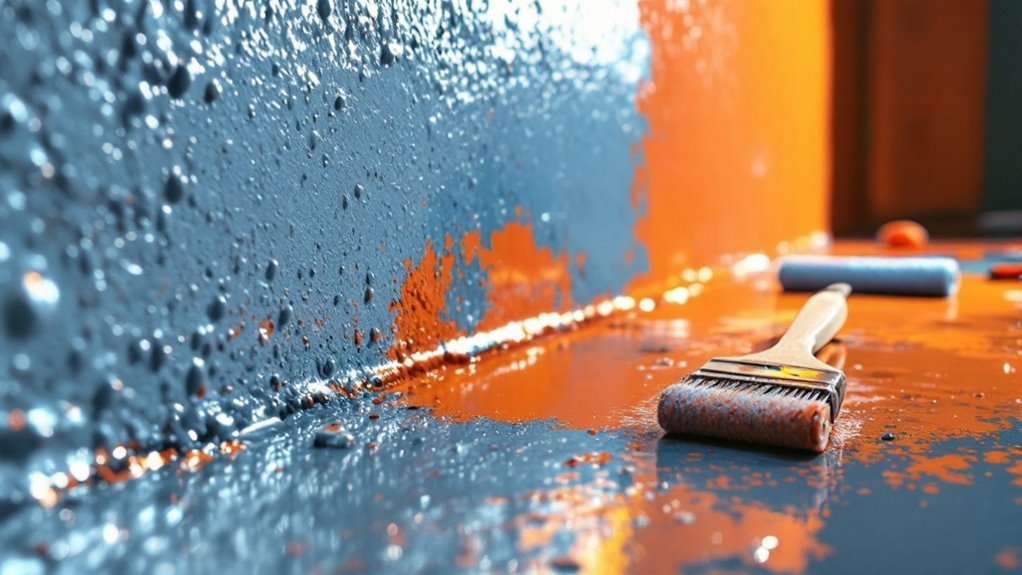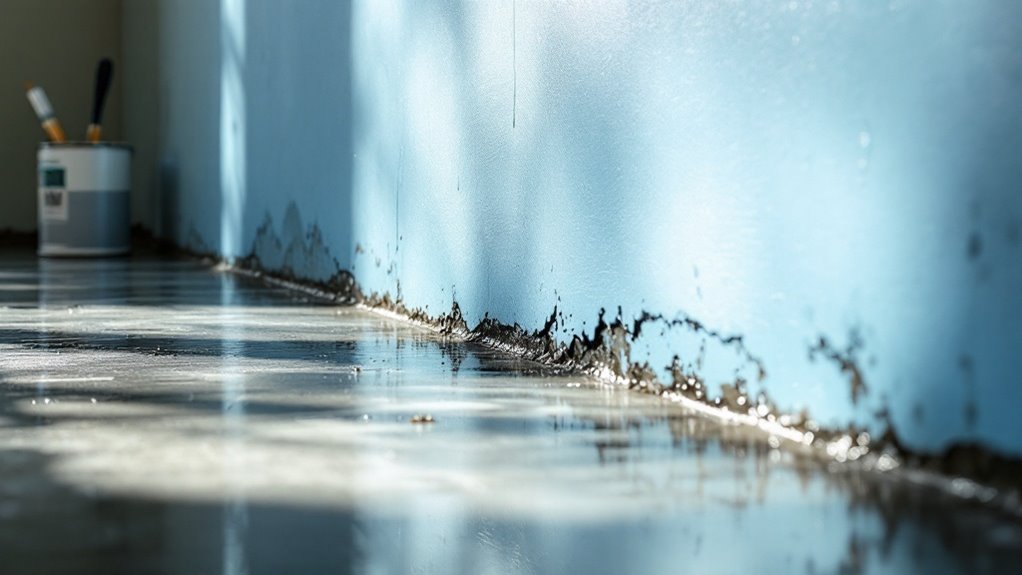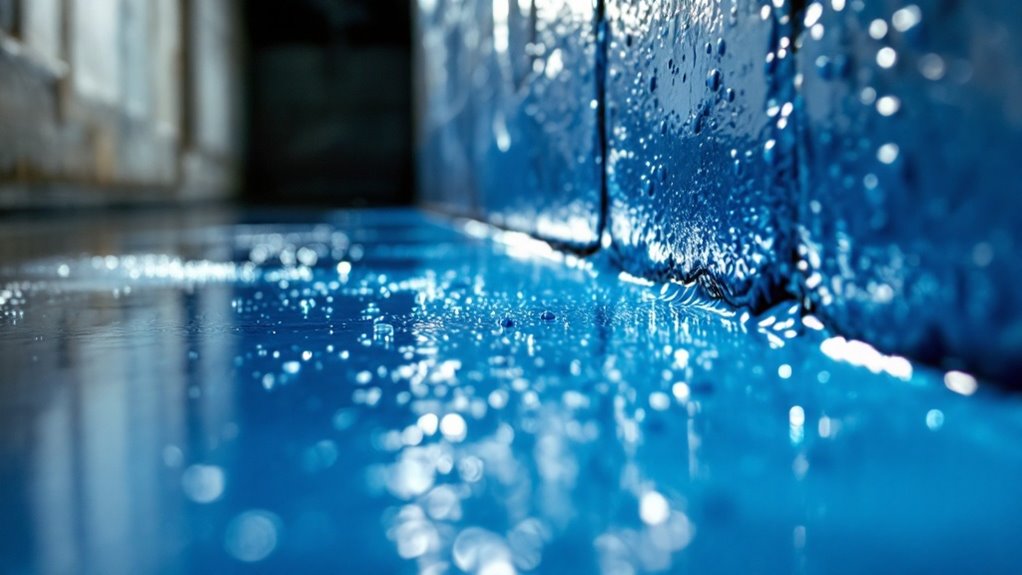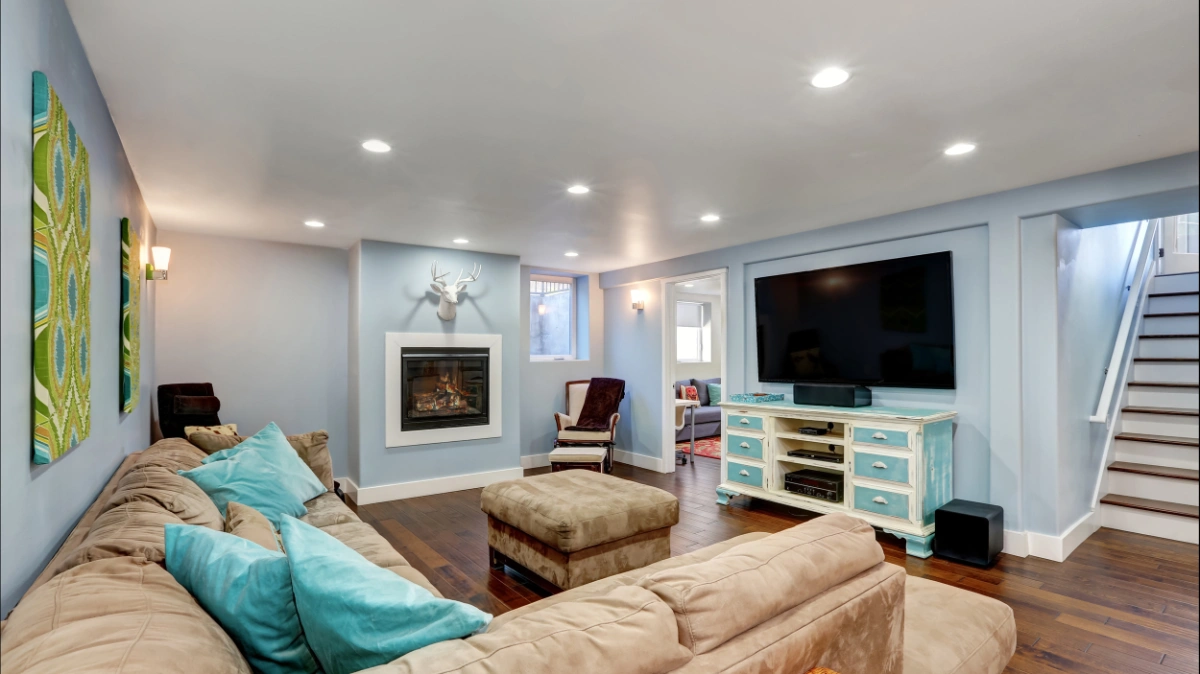Basement waterproofing paint can work for minor moisture issues, providing a temporary barrier against dampness and efflorescence. However, it won’t solve significant leaks or structural problems, as it fails to seal cracks and address root causes like hydrostatic pressure.
You’ll need proper surface preparation to maximize its effectiveness.
If you’ve got persistent moisture concerns, there are more reliable solutions available that you might want to explore to guarantee long-lasting protection.
Key Takeaways
- Basement waterproofing paint creates a barrier against minor moisture issues but is a temporary solution, lasting 6 to 24 months.
- It effectively manages damp spots and condensation but does not resolve structural cracks or significant leaks.
- Proper surface preparation is crucial for effectiveness; walls must be clean, dry, and free of cracks before application.
- The paint may mask underlying issues, potentially leading to mold growth and new cracks if not addressed.
- For persistent moisture problems, professional waterproofing solutions or alternatives are recommended for long-term protection.
Understanding Basement Waterproofing Paint

When it comes to protecting your basement from moisture, basement waterproofing paint is a practical solution you should consider. This liquid coating is applied to your interior walls using a roller or brush, sealing surfaces to create a barrier against water.
While it’s designed for minor moisture management—like damp spots and condensation—it effectively reduces dampness and controls efflorescence by limiting salt migration. It creates a hydrophobic layer, repelling minor water exposure, but doesn’t address structural cracks or significant leaks. For best results, ascertain your walls are clean and dry before application to maximize adhesion and effectiveness. Additionally, for more severe moisture issues, consider professional waterproofing solutions that ensure long-lasting protection.
Limitations and Failures of Waterproofing Paint

When considering waterproofing paint, you need to be aware of its limitations.
It may provide temporary resistance to moisture, but it often overlooks hidden structural issues that can lead to bigger problems down the line.
Plus, relying on paint as a long-term solution might leave you facing ongoing water intrusion challenges.
Hidden Structural Issues
Although waterproofing paint might seem like a quick fix for damp basements, it often masks deeper structural issues rather than resolving them. It fails to seal structural cracks, leaving vulnerabilities unaddressed.
Instead of fixing problems like soil settlement or poor drainage, it merely covers them up. Trapped moisture behind the paint can lead to mold growth and new cracks, accelerating deterioration.
Additionally, it hides persistent leaks, delaying necessary repairs. While you might enjoy a temporary aesthetic improvement, the long-term consequences can be severe, making it essential to tackle the underlying causes of moisture instead of relying on paint alone.
Temporary Water Resistance
Relying on waterproofing paint for your basement’s moisture problems often leads to disappointment, as its limitations become apparent shortly after application.
This paint typically fails within 6 to 24 months, succumbing to ongoing moisture pressure. It only addresses interior walls, leaving external water sources unchecked. Continuous seepage causes blisters and peeling, trapping moisture behind walls and weakening adhesion.
Additionally, it doesn’t seal structural cracks or handle hydrostatic pressure, making it ineffective against significant leaks. Ultimately, this temporary solution can create conditions for mold growth and accelerate wall deterioration, proving inadequate for long-term moisture management.
Inadequate Long-Term Solutions
While waterproofing paint may seem like an easy fix for basement moisture issues, it falls short as a long-term solution. Here are some limitations to evaluate:
- It doesn’t seal structural cracks or major leaks caused by hydrostatic pressure.
- It’s not a substitute for professional solutions addressing foundation damage.
- The paint has limited strength against water infiltration beyond surface dampness.
- It fails to repair cracks or porous masonry, which require physical sealing.
These factors can lead to more significant moisture problems, making waterproofing paint inadequate for lasting protection.
Proper assessment and repair are essential for effective long-term solutions.
Effectiveness for Minor Issues

When you’re dealing with minor dampness in your basement, waterproofing paint can be an effective short-term solution. It manages issues like efflorescence and condensation by repelling water with hydrophobic materials.
This paint creates a surface barrier that prevents water penetration, making it suitable for low-moisture basements with isolated dampness. However, it’s important to remember that this is a temporary fix.
Waterproofing paint won’t address root causes like poor drainage or hydrostatic pressure and is ineffective for structural water problems. For persistent issues, you’ll need to explore more thorough solutions.
Application Challenges
When applying basement waterproofing paint, you’ll face several challenges that can impact the outcome.
Proper surface preparation is essential; this means cleaning, etching, and sealing any cracks before you start.
If you skip these steps, you risk compromising the paint’s effectiveness and your basement’s waterproofing.
Preparation Requirements
Before you start applying basement waterproofing paint, you’ll face several preparation challenges that can impact your project’s success.
Here are key requirements to tackle:
- Debris Removal: Scrub walls to eliminate dirt, mold, and efflorescence.
- Drying Surfaces: Make certain walls are completely dry to avoid paint failure.
- Surface Smoothing: Scrape loose materials like old paint and crumbling mortar.
- Crack Sealing: Fill in cracks and holes for a uniform surface.
Addressing these challenges effectively sets the foundation for a successful waterproofing job, guaranteeing better adhesion and protection against moisture.
Application Limitations
Though basement waterproofing paint promises protection, it often comes with significant application limitations that can undermine its effectiveness. For instance, it can trap moisture behind the surface, leading to mold growth. Additionally, poor bonding to damp surfaces results in peeling and blistering.
| Challenges | Consequences |
|---|---|
| Trapped moisture | Mold growth, decay |
| Blistering and flaking | Frequent touch-ups needed |
| Incomplete sealing | Moisture intrusion |
These issues not only compromise the paint’s function but can also lead to costly repairs and ongoing maintenance.
Structural and Environmental Problems
While basement waterproofing paint may seem like a quick fix for moisture issues, it often fails to address the underlying structural and environmental problems.
Here are some key issues you should consider:
- Hydrostatic pressure can overwhelm paint, allowing water to seep through cracks.
- Cracks in masonry provide entry points that paint can’t seal.
- High water tables increase pressure beyond what paint can handle.
- Trapped moisture behind paint promotes mold growth and damages walls.
These factors reveal that paint alone won’t solve your basement’s water problems; you need to address the root causes for effective waterproofing.
Comparison to Professional Waterproofing Solutions
Addressing moisture issues in your basement requires more than just a layer of paint; it calls for thorough solutions that tackle the root causes of water intrusion.
Waterproofing paint struggles against hydrostatic pressure, allowing seepage through cracks. In contrast, professional systems use drainage and sealants to manage water flow effectively.
While paint may seem cost-effective initially, its frequent maintenance adds up, often leading to hidden repair costs.
Professional solutions provide lasting protection, improve indoor air quality, and greatly reduce the risk of mold and structural damage, making them a smarter investment for long-term peace of mind.
Best Practices for Using Waterproofing Paint
To effectively use waterproofing paint in your basement, it’s essential to follow best practices that guarantee a durable and efficient application.
To ensure a long-lasting waterproofing solution in your basement, adhere to essential best practices for application.
- Surface Preparation
- Clean walls thoroughly.
- Remove existing paint.
- Fill any cracks.
- Address efflorescence.
- Verify walls are dry.
- Application Technique
- Use a brush or roller.
- Apply in heavy coats.
- Allow proper drying time.
- Work in sections.
- Follow product instructions.
- Product Selection
- Choose quality brands.
- Check coverage rates.
- Confirm it’s suitable for below-grade.
- Verify ASTM standards.
- Read reviews.
- Maintenance
- Clean walls periodically.
- Inspect after rain.
- Reapply every few years.
- Avoid moisture introduction.
- Keep an eye on peeling.
Alternatives to Waterproofing Paint
When waterproofing your basement, waterproofing paint isn’t the only option available.
You might consider a French drain system, which redirects groundwater away using perforated pipes in gravel-filled trenches. This is ideal for areas with high water tables.
Exterior waterproofing solutions apply sealants to your basement walls, preventing moisture at the source.
For active water management, interior drainage and pump systems, like sump pumps and drain tiles, can effectively remove water.
Additionally, dehumidifiers help control humidity levels.
Each alternative has unique benefits, so assess your specific needs and conditions before deciding on the best solution for your basement.
Best approach for applying paint to waterproof your basement
So, if you think slapping on a coat of basement waterproofing paint is your golden ticket to a dry sanctuary, think again!
Sure, it might tackle minor leaks, but it’s like using a Band-Aid on a gaping wound. For serious issues, you’re better off calling in the pros.
Remember, while your DIY dreams are commendable, sometimes it pays to leave the heavy lifting to the experts—unless you enjoy swimming in a basement, of course!




